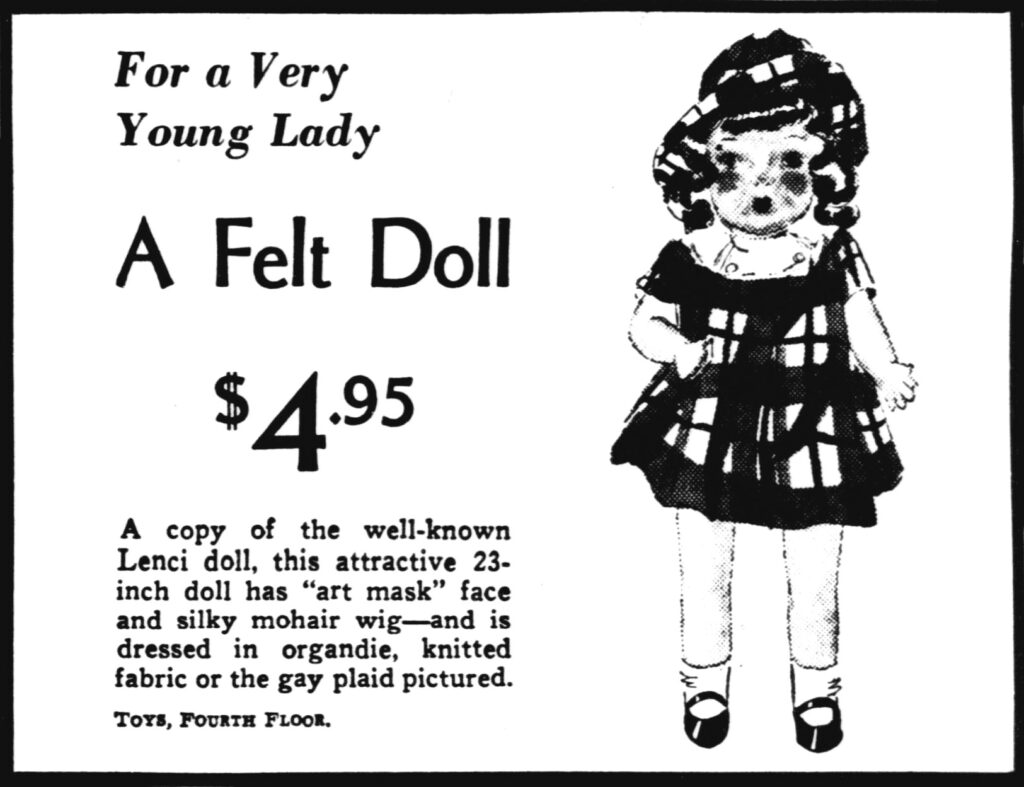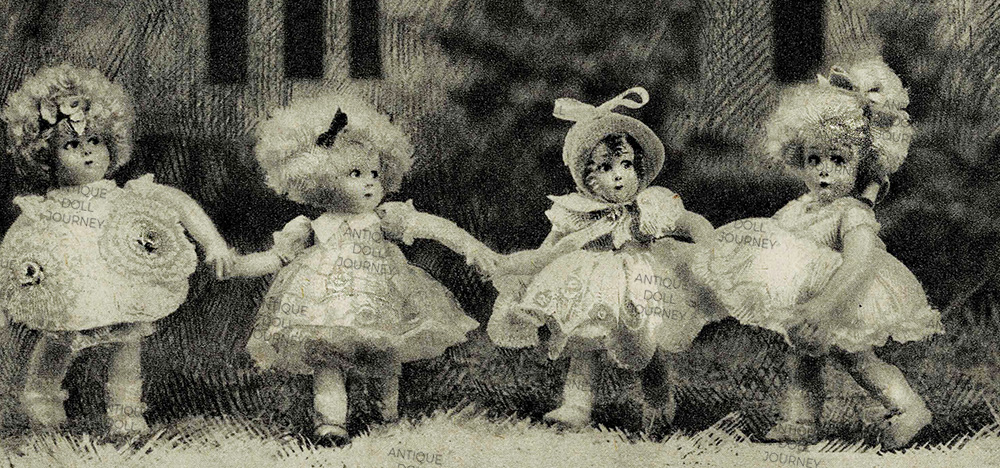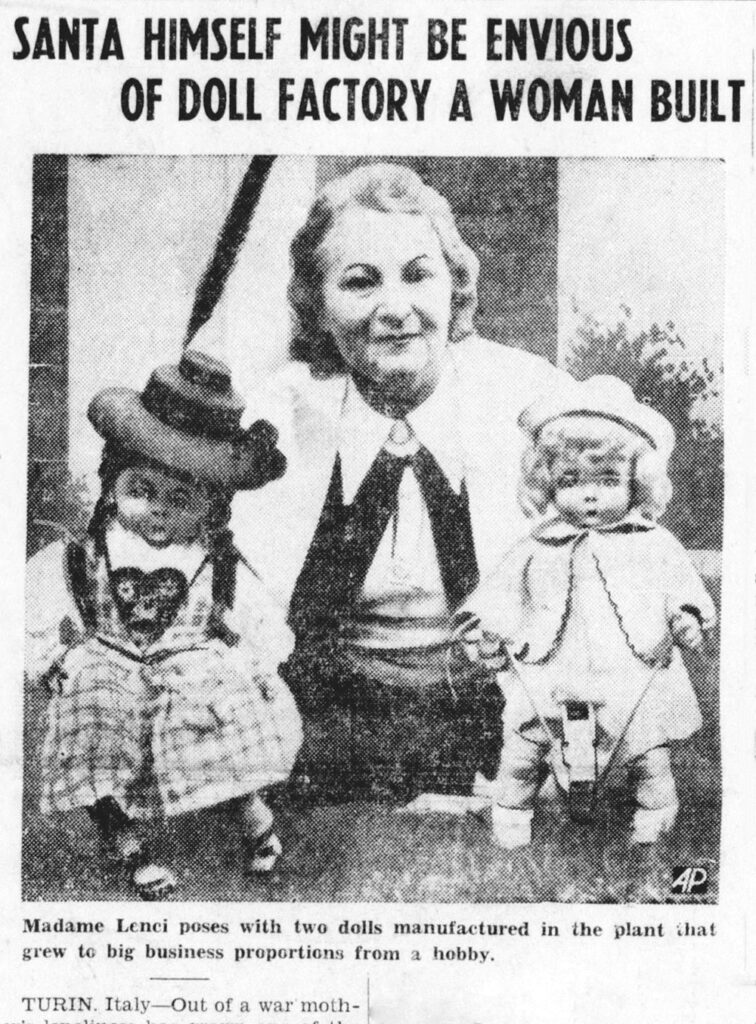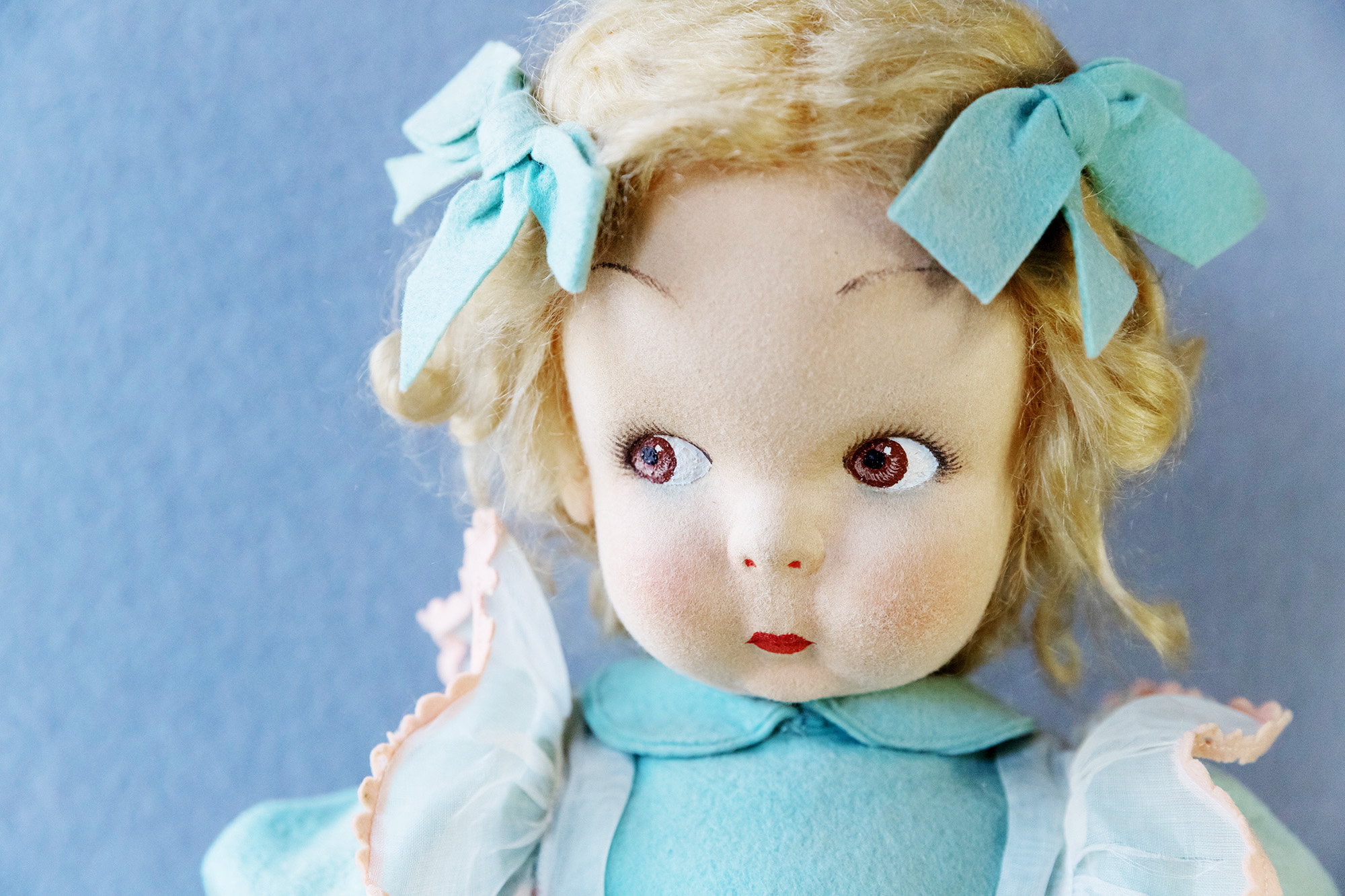The name Lenci is well known for the famous Italian felt dolls made in the 1920s. The doll company established in 1918 in Turino, Italy by Enrico di Scavini and Elena (nee König) Scavini. The name “Lenci” came from a pet name for Elena (Helenchen Kònig Scavini of Austrian origins) by the people of Turin who knew her as a child. Ugo Ojetti translated the name LENCI into Latin acrostic “Ludus est nobis constanter industria.”
In 1938 newspaper articles in the US reported that Elena’s husband went away during the first world war as an aviator and during that time her first child died. Elena began making dolls and fashions for them as a hobby during this time. She started with borsalina, a typical Tyrolean felt.
Emile Vanner represented the Lenci makers in France and abroad during the 1920s.
Italian newspapers called the sculptor of the Lenci dolls in 1932 Sandro Vachetti ” father of the dolls.”
Made in Germany First
The Scavinis had their earlier Lenci dolls manufactured in Germany. Later the manufacturing moved to Turin, Italy.
Registered Patent
On September 10, 1919 Enrico Scavini registered a patent in the U.S. for the pressing of the felt doll heads. The pressed doll heads had hand painted faces. Scavini’s patent for the manufacturing of heads of puppets, dolls, and like articles registered in the United States on September 6, 1921 (US 1389905). In the patent design a profile of a head shows how the felt layer lies on top of a fabric layer. The patent registration was signed on August 5, 1919.
The felt was hot pressed by either a single or a plurality of successive operations, into a matrix reproducing the shape of the article. During the operation a strongly starched layer of fabric, hot wetted, was located inside the surface of the article. After pressing the fabric adhered to the felt which absorbed some of the starch creating a strongly compact and durable shape.
If you want to see the patent at the USPTO site, click on public patent search, “Advanced Search” and type in Scavini in the search box. It is the only Scavini registration for 1921 in the list of dates that show in the results.
Doll Sales Catalog Copyright
Lenci di E. Scavini registered in the U.S. the copyright for the 1923 Lenci Dolls trade catalog.
Trademark Registration
Enrico Scavini had a trademark registration published July 29 of 1924 for DOLLS, MANIKEN DOLLS, FIGURE DOLLS, REPRESENTING ANIMALS, HUMAN FIGURES, AND GROTESQUE CHARACTERS: FAVORS, AND WHEELED TOYS. He filed the registration August 7, 1923. (Serial number 184, 187).
The scripted name of Lenci officially appeared as a registered trademark for clothes for women and children. The goods registered included hats and caps made of felt, straw, and silk; hosiery, underskirts, outer skirts, coats, jackets, boots, shoes, and gloves of leather and rubber, shawls, scarfs, and even sleeping garments. The registration claimed they had used this scripted Lenci name since February 27, 1920.
1923 Lenci Dolls in Ads & Displays
Lenci dolls displayed at the International Exhibition of Decorative Arts, in Monza in 1923. See an image of the display here.
Playthings Magazine
One can see two Lenci dolls in a full page ad in the 1923 Playthings magazine. The 1923 magazine gives Lenci di E. Scavini at the address of 58 W. 45th St, New York. A Charles Ernst served as the American manager for the Lenci Doll Company in 1923. Playthings lists a J. C. Messina as one traveling the country spreading the fame of the Scavini dolls.
In the March 1923 edition on page 141 introduces an image of the debut of “Fad-ette.” The doll wears high heel walking shoes, a fashionable hat, and carries a large round striped hat box on her arm. She wears a pair of slacks and a blouse as if she’s been out shopping in the streets of Paris.
An ad from June 1923 claimed that each doll was hand made in Turin, Italy. Then it claimed that one shop with only two sales people had sold over $2,500 worth of Lenci dolls in the 1922 season. Various dolls of the year appear in the ad.
The July edition of Playthings provides an illustration of larger boudoir doll along side the smaller child like versions. The ad claims that a Lenci dolls develop artistic tendencies in children. It encourages buyers they can place the doll on hassocks or use them to decorate their limousines.
The 1927 Playthings (December p. 236) shows eight left side glancing Lenci dolls stating the permanent display at 167 Madison Avenue. The ad lists Kirsh & Reale Inc. as the sole and exclusive agents in the United States. Interestingly they are the same dolls shown in an ad from August of 1923.
Salla Lenci
Ars Lenci di E. Scavini of Torino was listed among exhibitors for the Lenci Hall in the publication “Italy at the International Exhibition of Modern Decorative and Industrial Arts” for Paris in 1925. Both Enrico and his wife Elena exhibited doll furniture, fabrics and carpets, flowers, children’s clothing, hats, scarves, and accessories, and their creation of artist dolls and those dolls dressed children. View an image of the Lenci Gallery dolls on exhibit here and an image of their home goods on exhibit here. The publication also shares an image of two of the dolls.
The Lenci Factory
A German newspaper wrote in 1928 that Scavini employed 700 workers in order to meet the demands from all over the world.
1934 Evening Star Ad
Woodward & Lothrop advertised a Lenci Doll in 1934 in the Evening Star. The illustration of the doll shows her wearing a plaid organdie dress of knitted fabric with a mohair wig and ‘art mask’ face. It stood 23 inches tall and sold for $4.95.

Lord & Taylor Display
A window display of Lenci dolls featured at the well known Lord & Taylor shows off in the August 1923 edition.
Marshall Field & Company Display
Fashions of the Hour, a Marshall Field & Company magazine, shows a display of two Lenci dolls along with Kathe Kruse dolls on the fourth floor of a department store in the Christmas 1926 edition.
The Christmas 1928 edition shares a display scene of three Lenci dolls watching a puppet show and feeling very upset. They name the dolls in the image as Rosa, Maria, and Scotty.
Lenci Fashions
The Lenci company was known to design children’s clothing fashioned to match the dolls. For example, Marshal Field & Company advertised a Lenci hat and coat with matching doll imported from Italy sold at their 5th Avenue shop (Infant and Children’s Review, December 1926.)
The 1927 edition of Infants and Children’s Wear Review provides an image of a window store display of Lenci dolls along with children’s fashions. The display description explains that the dolls were dressed in doll sizes of the life size child sizes. One can read about the children’s fashions designed by Lenci using felt as used on the dolls in this magazine such as November’s mention of a Fall fashion show in Bridgeport, Connecticut.
The Fashions of the Hour even mentions things like Lenci felt flowers for decorating presents.
The Christmas 1928 edition illustrates a girl’s tam cap by Lenci selling for $4.50.

Lenci During the 1930s-1940s
Due the collapse of the worldwide market in 1929 and the sanctions, Pilade Garella took over the company in 1936. Pilade’s son Beppe Garella joined around 1946.
Italian Ball Costume
In 1934 the Italian Embassy held a Masqued Ball type event where people attended in various lively costumes. Mrs. Magda Shernadori Belingardi, wife of the air attache of the Italian Embassy, wore a dress representing the Lenci Doll designs. Her photo appeared on the first page of the Evening Star, April 15, 1934.
Dolls Presented to Rulers and Royalty
During the late 1930s the factory employed about 360 workers. Rulers and royalty from various countries bought Lenci dolls: the queen of England, Crown Prince Umberto, and even the largest order came from IL DUCE (Benito Mussolini) who presented the dolls as gifts to the leader of Japan at $100 each. The dolls purchased by Mussolini even wore jewels.
A newspaper article in 1938 reported Japanese journalists scheduled to visit the Lenci Doll factory.

Misleading Misinformation
Newspapers in the US in the early 1940s misled Americans about the beginnings of the Lenci doll creations with inaccurate information. Even though Enrico Scavini survived the first war and did not die until 1938 before the second war, newspapers in the early 1940s in the US told American readers that Elena started making the dolls after her husband died in the World War (see The Midland Journal, 1940 Jan 26, p 4 and The Skyland Post, 1941 December 4, p. 10). Most likely the reporters either received wrong information regarding the death of Elena’s child or the rewording was done purposefully to try to cause sympathy among American shoppers to boost their sales.
The Lenci doll factory was bombed in 1943 during WWII.
Washable Felt
For collectors, the antique Lenci doll presents challenges due to the difficulty in cleaning felt. In 1932 an italian newspaper article claimed that the Lenci factory had changed the type of felt used in order to make the dolls washable. The felt was soaked in a rubber solution to try to make this possible.
Names of Lenci Dolls
The Lenci dolls had individual names. The company gave them names like Chicchi, Mariuccki. Benedetta, Lucia, Mio tosoro, and Mia amica.
Lenci Ceramics
Lenci also manufactured porcelain ceramics such as Madonnas, nudes, modern figures, plates, animals, pathetic or caricatural groups. A great majority of the pieces represented many small masterpieces. Artists of the ceramics were (after Vacchetti and the Lenci sisters) Tosalli, Grande, Chessa, Da Milano, and Levi-Montalcini. (La Stampa Della, May 31, 1932, p.2).
Competition and Counterfeits
Germany recognized the success and threat of the successful Lenci dolls. In 1922 an article appeared in the German newpaper mentioning the Lenci dolls. The writer of the article highlights the success of a local doll maker who had created a type of doll similar in type that could also model children’s clothing. The doll was on display at the Teitz Department Store.
Closure
In 1997 the Garella family sold the Lenci company to Bambole Italiane. But in July of 2001 the Lenci company finally closed its doors. Bambole Italiane S.rl. officially lidquidated on June 18, 2002 in Italian court. Patents and trademarks sold to Westbay Serviços e Investimento di Madeira.
——-
See more about antique German dolls here.
See more about antique French dolls here.
